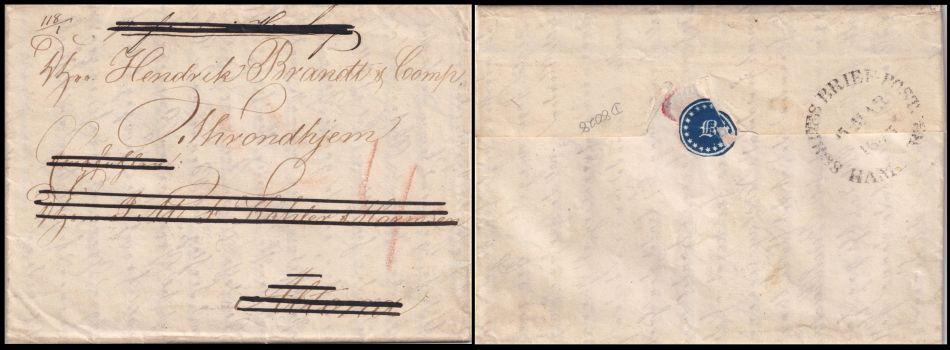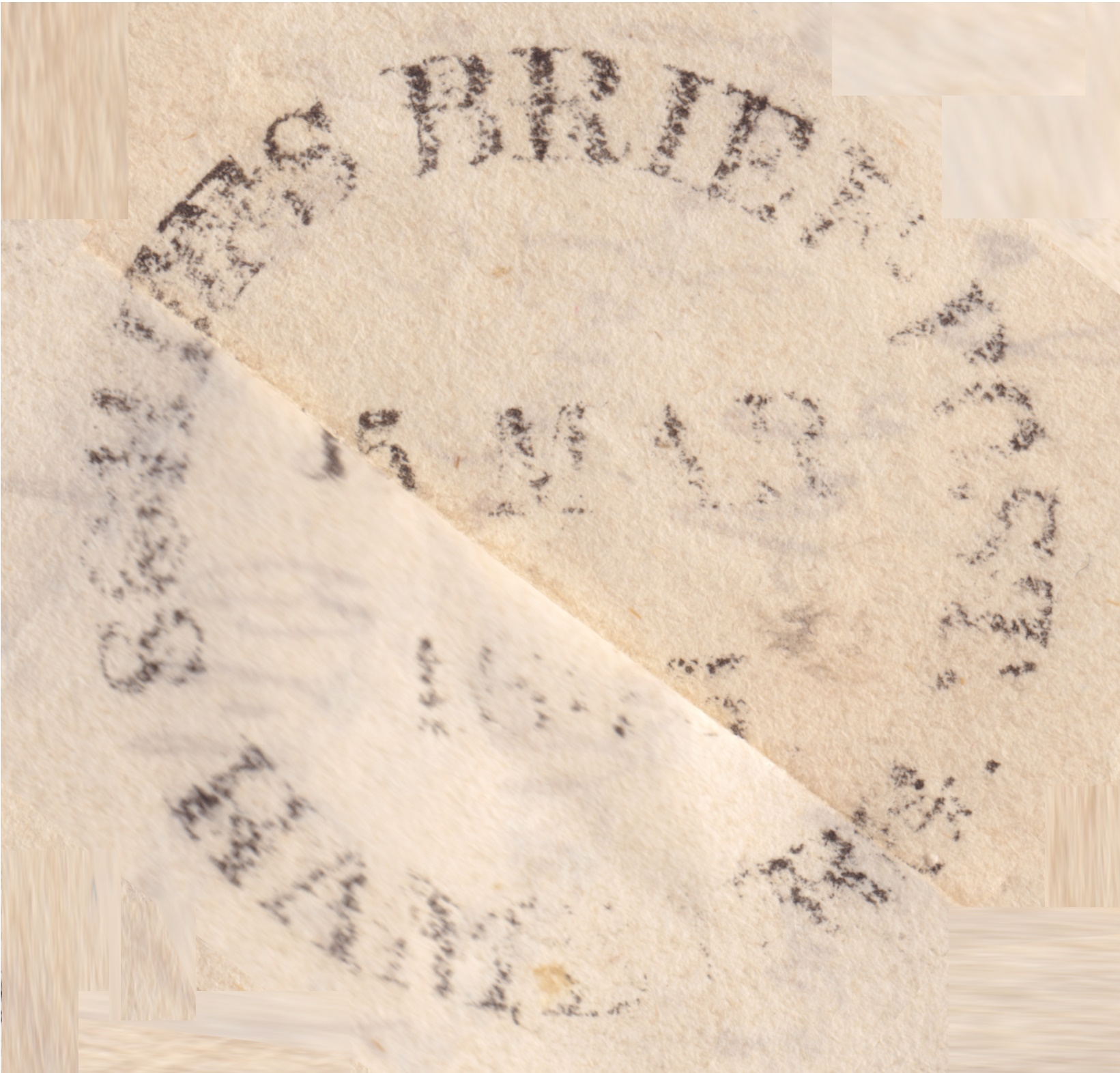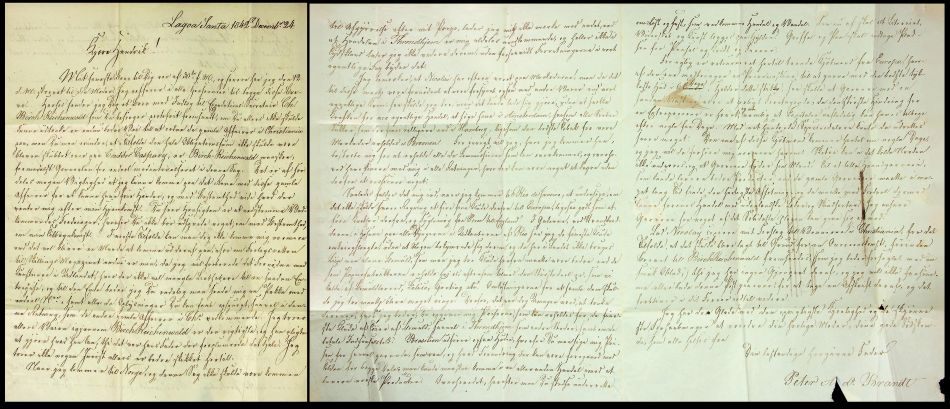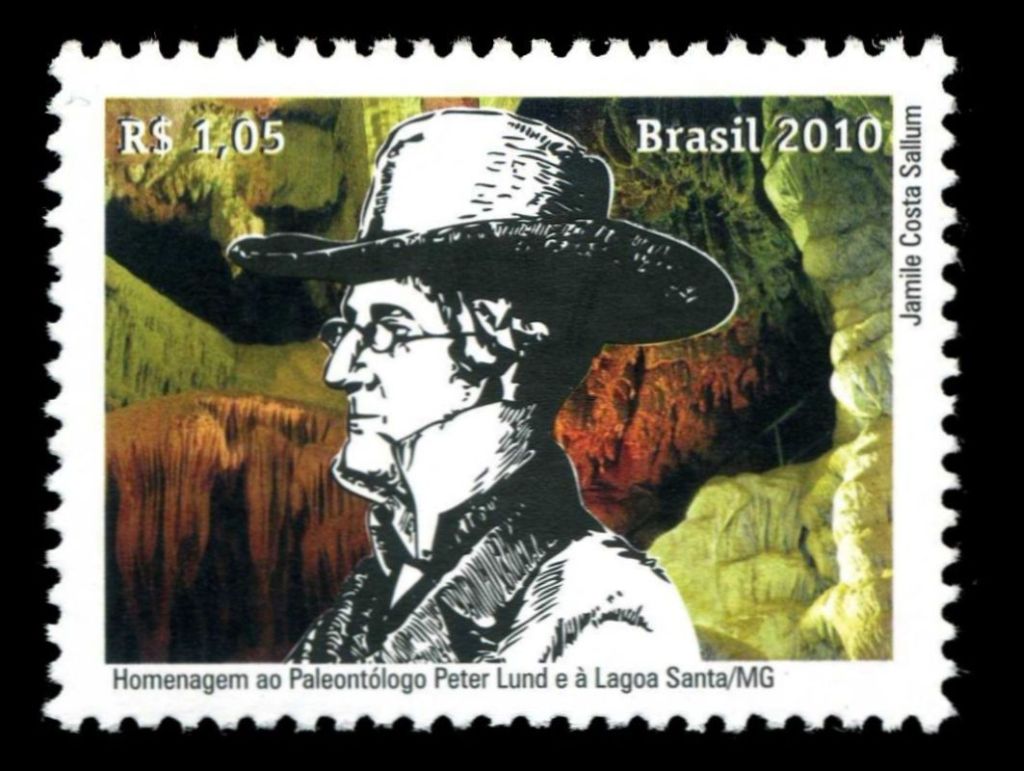the place where Paleontology and Paleoanthropology meets Philately
Letter from Peter Andreas Brandt, 1842
Peter Andreas Brandt (14 June 1792, Trondheim, Norway – 20 September 1862, Lagoa Santa, Minas Gerais, Brazil), was a Norwegian painter and illustrator, who worked as an illustrator with the Danish paleontologist Peter Wilhelm Lund in Brazil.
 |
| The envelope with the letter from Peter Andreas Brandt 1842 |
The letter was written on December 24th, 1842, and dispatched in a folded letter-sheet from Lagoa Santa, Brazil.
The front side of the letter is notably detailed.
- The number "118/1" in the top-left corner is likely the reference number, added by the postal clerk at the office where the letter was handed in.
- The big black letter "P" on the top of the cover probably denotes "Transit Post".
- The letter was addressed to son of Peter Bradt, Hendrick in Trondheim (formerly spelled Throndhjem), Norway.
While Hendrick Brandt was located in the birthplace of Peter Brandt, it is likely they were relatives. - Several intermediate routing marks have been crossed out:
- Altona (bottom), which at the time was a town in Denmark, but is now within the city of Hamburg, Germany.
The line above Altona bears the name of the forwarding agent, "Kahler Hamrmsen", who was responsible for sending the letter onward to Norway.
- Christiania (above the the forwarding agent name), is the historical name for present-day Oslo, Norway.
- Altona (bottom), which at the time was a town in Denmark, but is now within the city of Hamburg, Germany.
- The large red numeral "4", on the right, most likely indicates a fee of 4 skilling, corresponding to the postage for the domestic leg in Norway from Christiania to Throndhjem.
 |
| The Ship Letter Post postmark on the reverse side of the envelope |
The postmark was likely applied in Hamburg a major German port city near Altona, when the letter, originating from Lagoa Santa, Brazil, reached Hamburg after a transatlantic voyage from Rio de Janeiro, processed on March 15, 1843. This fits the timeline from the document’s December 24, 1842, date, accounting for a 6–8 week sea journey.
Based on historical shipping and postal practices in the 1840s, the route from Lagoa Santa, Minas Gerais, Brazil, to Altona, Denmark, likely involved several stages. Mail from Lagoa Santa would first be transported to Rio de Janeiro, the primary Brazilian port, taking days to weeks depending on overland conditions. From Rio, the letter would join transatlantic shipping routes, with "Schiffs Brief Post" indicating it was carried by a German vessel, likely departing for Hamburg. The Hamburg-America Line, though formally established in 1847, had precursor shipping activities, and German ships were active in the South Atlantic trade by the early 1840s, connecting Brazil to European ports like Hamburg. Hamburg was a key entry point for transatlantic mail in the 1840s, especially for German ships carrying mail to Altona, under Danish control until 1864.
The blue sticker is not an official postal marking but a personal wax or wafer seal bearing the letter "B", presumably for "Brandt." Such seals were commonly used in the mid-19th century to secure correspondence and authenticate the sender.
 |
| A letter dated December 24, 1842, written by Peter Andreas Brandt in Lagoa Santa, Brazil (transcript and trnslation are here). |
This three-page letter, dated December 24, 1842, was written by Norwegian artist Peter Andreas Brandt
(1792–1862) to his son Hendrik.
It is characteristic of Brandt’s correspondence from this period, when he still believed he might
return to Norway and hoped that his affairs there could somehow be set in order.
In the end, however, he never returned, dying in Brazil in 1862.
This is the only known letter from Brandt to his son Hendrik, although several survive addressed to
Christian Birch-Reichenwald, who is also mentioned in the present letter.
In 1832, Brandt had taken out a large loan to launch the first illustrated review in Scandinavia.
The venture failed in 1834, leaving him heavily in debt—among other creditors was the confectioner Caspari,
also referred to in this letter.
Fleeing both debt and family, Brandt left for Brazil, where he met naturalist Peter Wilhelm Lund and
offered his services as illustrator.
The partnership proved highly successful, and Brandt’s natural history illustrations and surveys of caves
are of exceptional quality.
For many years, Brandt harboured hopes of returning to Norway, but his tangled financial situation
remained a barrier.
An enterprising spirit, though lacking any real business acumen, he repeatedly devised new commercial
or publishing schemes.
The range of possibilities outlined in this letter mirrors the tone and content of many of his other
surviving letters, most of which are preserved today in the Norwegian National Archives.
The Partnership of Peter Andreas Brandt and Peter Wilhelm Lund
In the 1830s, Peter Andreas Brandt and Peter Wilhelm Lund joined forces in Lagoa Santa, a region known for its extensive limestone cave systems.|
Peter Andreas Brandt trained in Norway and skilled in both topographic and naturalistic drawing,
Brandt combined artistic talent with scientific curiosity.
He likely arrived in Brazil circa 1831, possibly landing first in Rio de Janeiro, as many European travellers did at the time. Though the exact reasons for his emigration are not fully documented, it's likely he was seeking new work and adventure, as Brazil had become a hub for European artists, scientists, and intellectuals following its independence in 1822. Brandt eventually settled in Minas Gerais, where he met Peter Lund. Their encounter marked the beginning of a decades-long partnership. Brandt became Lund’s principal illustrator, producing highly detailed drawings of fossils, cave structures, excavation sites, and Brazilian landscapes. |
Peter Wilhelm Lund
(14 June 1801, Copenhagen, Denmark – 25 May 1880, Lagoa Santa, Minas Gerais, Brazil)
was a Danish-born paleontologist, zoologist, and archaeologist
who spent most of his life in Brazil.
He is widely regarded as the founding figure of both Brazilian paleontology and archaeology. Lund was the first to describe numerous species of Pleistocene megafauna, including the iconic saber-toothed cat Smilodon populator. His most revolutionary contribution came with the discovery that humans had coexisted with now-extinct animals in prehistoric Brazil — a claim that challenged prevailing scientific views at the time and may have contributed to his eventual decision to cease publishing. His extensive fossil and archaeological collections are now housed at the Natural History Museum of Denmark in Copenhagen. Lund first arrived in Brazil in 1825, primarily seeking relief from health issues. He returned to Europe in 1829 to complete his doctoral degree in natural history at the University of Kiel, but by 1833, he had returned to Brazil. He settled in Minas Gerais, where he dedicated the remainder of his life to fieldwork and research in the caves of Lagoa Santa. |
 |
| Peter Lund on postage stamp of Brazil 2010 |
Lund depended on Brandt’s artistic precision to communicate his research to European audiences, particularly through scientific publications in Denmark. The drawings accompanied reports and presentations, enabling readers to visualize the complex geological and paleontological contexts with accuracy and detail.
Brandt participated in many of Lund’s field expeditions, contributing not only as an artist but also as a topographer. His maps and cross-sections of cave interiors were invaluable in understanding the spatial relationships and geological settings of the fossil deposits. These visual tools supported Lund's analytical work and enriched the scientific interpretation of the caves’ contents.
Scientific Publications of 1842
The year 1842, the year when Peter Brandt wrote the letter, marked a productive period for the team. Lund published several key articles in the Naturvidenskabelige og Mathematiske Afhandlinger (Royal Danish Academy of Sciences), including:

|
| Peter Lund at work in the Lappa do Mosquito near Lagoa Santa, by Peter Brandt, created in 1840 (the year when the first adhesive stamp, the Penny Black, was issued in Great Britain). Image credit: Wikimedia |
- “Lagoa Santa den 30te Januar 1841”
- “Fortsatte Bemærkninger over Brasiliens Uddöde Dyrskabning” (“Continued Remarks on the Extinct Fauna of Brazil”)
In a letter to his brother in 1842, Lund offered heartfelt praise for Brandt, describing him not just as an assistant but as an indispensable companion:
He copies my works in fair handwriting and serves as reader when I am tired… accompanies me on travels… is the most zealous worker
in the caves, cares for me when I am ill, hosts visitors.… day and night at my service…
Acknowledgements
- Many thanks to Mr. Dan Brennan from Great Britain for his assistance in researching the letter.
- Many thanks to Mrs. Birgitte Holten, author of a biography of Peter Brandt for her assistance in researching the letter.
References:

|
- Peter Andreas Brandt (1792-1862):
Wikipedia, - Peter Wilhelm Lund (1801-1880):
Wikipedia, "Tribute to paleontologist Peter Lund and Lagoa Santa/MG".